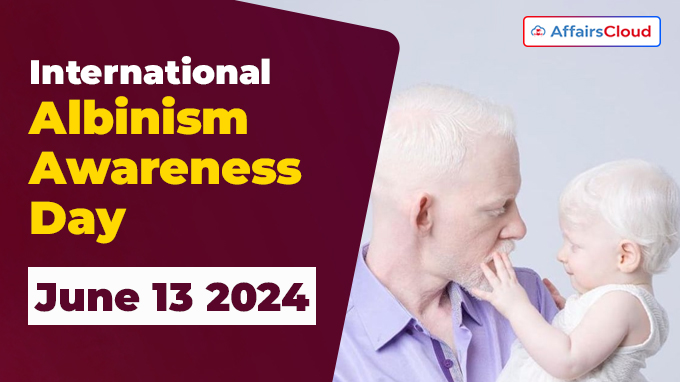 The United Nations (UN)’s International Albinism Awareness Day (IAAD) is annually observed across the globe on 13th June to create awareness about albinism, an inherited genetic condition that people are born with, and celebrate and advance the human rights of persons with albinism globally.
The United Nations (UN)’s International Albinism Awareness Day (IAAD) is annually observed across the globe on 13th June to create awareness about albinism, an inherited genetic condition that people are born with, and celebrate and advance the human rights of persons with albinism globally.
13th June 2024 marks the observance of the 10th IAAD.
Theme:
The theme of IAAD 2024 is “10 Years of IAAD: A Decade of collective progress”.
The 2024 theme acknowledges the relentless work of albinism groups globally and recognise the strides made within the movement, reinforcing commitment for future advancements.
Background:
i.In 2013, the UN Human Rights Council (UNHRC) adopted resolution A/HRC/RES/23/13, focusing on preventing attacks and discrimination against persons with albinism.
ii.On 18 December 2014, the UN General Assembly (UNGA) adopted the resolution A/RES/69/170, proclaiming 13 June as an International Albinism Awareness Day, with effect from 2015.
iii.The first-ever International Albinism Awareness Day was observed on 13 June 2015.
Why June 13?
June 13 was chosen as IAAD since it was on that day in 2013 that the UNHRC adopted its first-ever resolution on albinism (A/HRC/RES/23/13).
Mandate of Independent Expert:
i.In April 2015, the UNHRC adopted the resolution A/HRC/RES/28/6 to establish the mandate of an Independent Expert on the enjoyment of human rights by persons with albinism.
ii.In June 2015, the UNHRC appointed Ikponwosa Ero (Nigeria) as the 1st Independent Expert on the enjoyment of human rights by persons with albinism.
- In August 2021, she was succeeded by Muluka-Anne Miti-Drummond (Zambia).
Note: The mandate was extended on 4 April 2024 through resolution A/HRC/RES/55/18.
What is Albinism?
i.Albinism is a rare, non-contagious, genetically inherited condition that reduces melanin pigment in the skin, hair, and eyes.
ii.It is caused by mutations in specific genes, responsible for melanin production. It occurs across all racial and ethnic groups globally.
- Melanin is a chemical in the human body that determines the colour of skin, hair, and eyes.
iii.People with albinism have impaired vision due to the lack of pigment needed for normal eye development. Many are legally blind.
iv.Their vulnerability to sun exposure can lead to skin cancer and severe visual impairment.
Types:
i.Oculocutaneous albinism, or OCA, is the most common type of albinism. People with OCA have extremely pale hair, skin, and eyes.
ii.Hermansky-Pudlak Syndrome (HPS) and Chediak-Higashi Syndrome (CHS) are rarer forms involving additional health issues like blood clotting and hearing problems.
Key Facts:
i.A majority of persons with albinism die from skin cancer between 30 and 40 years of age.
ii.Prevalence:
- In North America and Europe, 1 in 17,000 to 20,000 people have albinism.
- In sub-Saharan Africa, the rate is higher, with 1 in 1,400 in Tanzania and as high as 1 in 1,000 in certain groups in Southern Africa.




